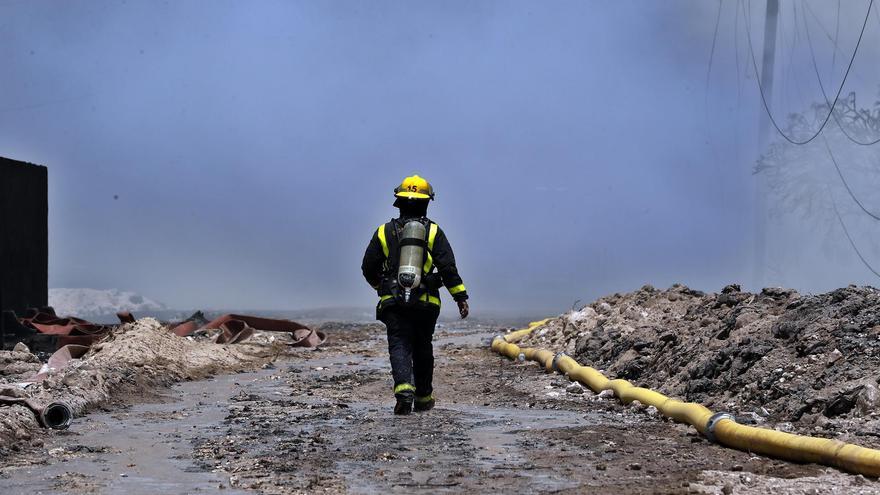
![]() 14ymedio, Havana, 10 August 2022 — The official information is that the fire that has been devouring the Matanzas Supertanker Base since Friday began to subside this Tuesday. The Cuban Fire Department confirmed that the fourth tank, which exploded on Monday night, collapsed completely, and the state press itself published images of the four melted tanks.
14ymedio, Havana, 10 August 2022 — The official information is that the fire that has been devouring the Matanzas Supertanker Base since Friday began to subside this Tuesday. The Cuban Fire Department confirmed that the fourth tank, which exploded on Monday night, collapsed completely, and the state press itself published images of the four melted tanks.
Despite the fact that the authorities insist that “successful work is being done on extinguishing the fire” and that the spread of fire to the rest of the port facilities was prevented — there are four other tanks similar to those destroyed — they warn that “there are still flames” on the surface of the tanks and that “the risk continues.”
“It’s still a big fire, but we see a different situation than yesterday,” Alexander Ávalos Jorge, Assistant Chief of the National Fire Department and Firefighter Team said at a press conference on Tuesday.
President Miguel Díaz-Canel showed up at the site to evaluate the progress of the work and said that there are still “possibilities that the fuel will catch fire again.”
Support teams from Venezuela and Mexico, EFE reported, were able to start the hydraulic pump that they had installed and hadn’t been able to operate. On Tuesday, in addition, two ships with the Mexican flag arrived: the Liberator, of the Ministry of the Navy, with a helicopter to help, and the Bourbon Artabaze, a private ship hired by the state-owned Petróleos Mexicanos (Pemex), specializing in putting out fires in marine oil facilities.
The Mexican delegation, which began arriving on Saturday night, has sent almost 45,000 liters of retardant foam and two specialized irrigation pumps to the island on 13 flights.
The images disseminated show that the black smoke from the accident has turned gray, since the fuel from the tanks has been consumed. Each tank has a capacity of 50,000 cubic meters (50 million liters) and was filled with an indeterminate amount of fuel.
The government’s version is that lightning struck one of the warehouses on Friday afternoon and, in circumstances not yet explained, since that type of facility must have protection against that natural event, it lit a fuel tank with 25,000 cubic meters of national crude oil. In the following days, the fire reached the neighboring tanks one by one, between explosions that were broadcast live not only by private users but also by state television.
While working on extinguishing the first fire, the explosion of the second tank caused the death of firefighter Juan Carlos Santana Garrido, whose body was found on Saturday, and the disappearance of 14 others, most of them young people aged 18 and 19 who were going through military service, as witnessed by the desperate calls of relatives on social networks.
The Government has not published the list of these missing persons or acknowledged any more deaths and has already announced that the recovery of the bodies will not begin until the flames are extinguished. This lack of transparency results in the dissemination of contradictory information.
Relatives of one of the missing, Leo Alejandro Doval Pérez de Prado, only 19, wrote messages on social networks considering him dead, but this newspaper is waiting for confirmation from the family. Likewise, official journalists reported that Michel Rodríguez Román, 20, had died, but later deleted the information. Both boys were in military service.
In its latest report, Cuba’s Ministry of Health pointed out that of the total of 125 injured in the accident, 19 are hospitalized, 5 of them critical, 2 serious and 12 with “care.”
Another effect of the accident was the shutdown, on Monday, of the largest thermoelectric power plant in Cuba, Antonio Guiteras, located almost five kilometers from the Supertanker Base.
Although the Electric Union of Cuba (UNE) reported that it had begun to get the plant back in service, an attempt was thwarted on Tuesday night. “Just a few minutes after synchronizing with the national electrical system, the Antonio Guiteras thermoelectric plant went down again, as a result of a shot,” official journalist Lázaro Manuel Alonso posted on Facebook, without giving more detail about what he was referring to. The UNE, for its part, indicated that it was “for unknown reasons” that are being investigated.
In any case, a new day of blackouts presented itself. On Tuesday, only 60% of the island’s energy demand was met.
Translated by Regina Anavy
____________
COLLABORATE WITH OUR WORK: The 14ymedio team is committed to practicing serious journalism that reflects Cuba’s reality in all its depth. Thank you for joining us on this long journey. We invite you to continue supporting us by becoming a member of 14ymedio now. Together we can continue transforming journalism in Cuba.
